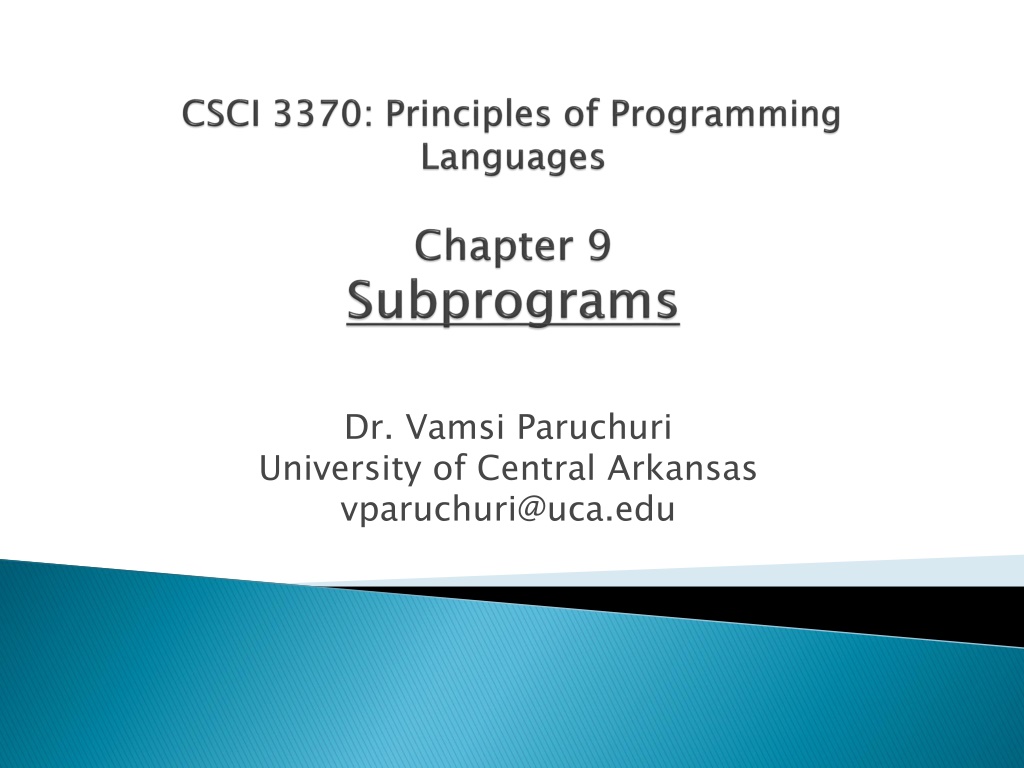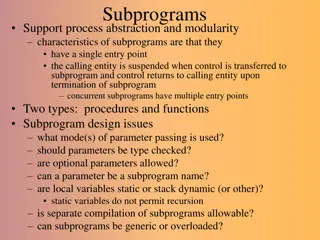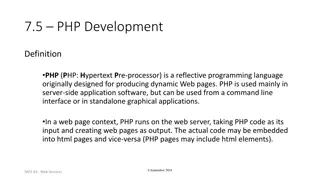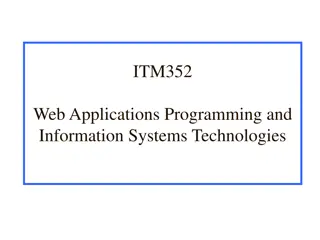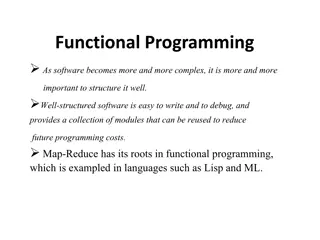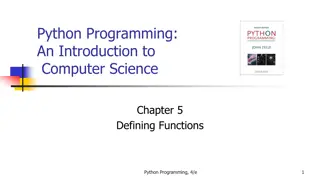Understanding Subprograms in Programming
Delve into the fundamentals of subprograms, including design issues, local referencing environments, parameter-passing methods, and more. Explore the abstraction facilities, subprogram definitions, declarations, and the binding of actual parameters to formal parameters. Gain insights into the protocols and nuances of subprogram interfaces in C and C++ programming languages.
Download Presentation

Please find below an Image/Link to download the presentation.
The content on the website is provided AS IS for your information and personal use only. It may not be sold, licensed, or shared on other websites without obtaining consent from the author. Download presentation by click this link. If you encounter any issues during the download, it is possible that the publisher has removed the file from their server.
E N D
Presentation Transcript
Dr. Vamsi Paruchuri University of Central Arkansas vparuchuri@uca.edu
Introduction Fundamentals of Subprograms Design Issues for Subprograms Local Referencing Environments Parameter-Passing Methods Parameters That Are Subprogram Names Overloaded Subprograms Generic Subprograms Design Issues for Functions User-Defined Overloaded Operators Coroutines
Two fundamental abstraction facilities Process abstraction Emphasized from early days Data abstraction Emphasized in the1980s Fundamentals of Subprograms Each subprogram has a single entry point The calling program is suspended during execution of the called subprogram Control always returns to the caller when the called subprogram s execution terminates Fundamentals of Subprograms
A subprogram definition describes the interface to and the actions of the subprogram abstraction A subprogram call is an explicit request that the subprogram be executed A subprogram header is the part of the definition, including the name, the kind of subprogram, and the formal parameters The parameter profile (aka signature) of a subprogram is the number, order, and types of its parameters The protocol is a subprogram s parameter profile and, if it is a function, its return type
Function declarations in C and C++ are often called prototypes A subprogram declaration provides the protocol, but not the body, of the subprogram A formal parameter is a dummy variable listed in the subprogram header and used in the subprogram An actual parameter represents a value or address used in the subprogram call statement
Positional The binding of actual parameters to formal parameters is by position: the first actual parameter is bound to the first formal parameter and so forth Safe and effective Keyword The name of the formal parameter to which an actual parameter is to be bound is specified with the actual parameter Parameters can appear in any order
In certain languages (e.g., C++, Ada), formal parameters can have default values (if no actual parameter is passed) In C++, default parameters must appear last because parameters are positionally associated C# methods can accept a variable number of parameters as long as they are of the same type public void public void DisplayList(params params int int[] [] list) { }
There are two categories of subprograms Procedures are collection of statements that define parameterized computations No return Functions structurally resemble procedures but are semantically modeled on mathematical functions They are expected to produce no side effects In practice, program functions have side effects
What parameter passing methods are provided? Are parameter types checked? Are local variables static or dynamic? Can subprogram definitions appear in other subprogram definitions? Can subprograms be overloaded? Can subprogram be generic?
Local variables can be stack-dynamic (bound to storage) Advantages Support for recursion Storage for locals is shared among some subprograms Disadvantages Allocation/de-allocation, initialization time Indirect addressing Subprograms cannot be history sensitive Local variables can be static More efficient (no indirection) No run-time overhead Cannot support recursion
Ways in which parameters are transmitted to and/or from called subprograms Pass-by-value Pass-by-result Pass-by-value-result Pass-by-reference Pass-by-name
The value of the actual parameter is used to initialize the corresponding formal parameter Normally implemented by copying Can be implemented by transmitting an access path but not recommended (enforcing write protection is not easy) When copies are used, additional storage is required Storage and copy operations can be costly
When a parameter is passed by result, no value is transmitted to the subprogram; the corresponding formal parameter acts as a local variable; its value is transmitted to caller s actual parameter when control is returned to the caller Require extra storage location and copy operation
A combination of pass-by-value and pass-by-result Sometimes called pass-by-copy Formal parameters have local storage Disadvantages: Those of pass-by-result Those of pass-by-value
Pass an access path Also called pass-by-sharing Passing process is efficient (no copying and no duplicated storage) Disadvantages Slower accesses (compared to pass-by- value) to formal parameters Potentials for un-wanted side effects Un-wanted aliases (access broadened)
By textual substitution Formals are bound to an access method at the time of the call, but actual binding to a value or address takes place at the time of a reference or assignment Allows flexibility in late binding Not part of any widely used language
In most language parameter communication takes place thru the run-time stack Pass-by-reference is the simplest to implement; only an address is placed in the stack
Fortran Always used the inout semantics model Before Fortran 77: pass-by-reference Fortran 77 and later: scalar variables are often passed by value-result C Only Pass-by-value Pass-by-reference is achieved by using pointers as parameters C++ A special pointer type called reference type for pass-by- reference Java All parameters are passed by value Object parameters are passed by reference
Ada Three semantics modes of parameter transmission: in, out, in out; in is the default mode Formal parameters declared out can be assigned but not referenced; those declared in can be referenced but not assigned; in out parameters can be referenced and assigned C# Default method: pass-by-value Pass-by-reference is specified by preceding both a formal parameter and its actual parameter with ref
Considered very important for reliability FORTRAN 77 and original C: none Pascal, FORTRAN 90, Java, and Ada: it is always required ANSI C and C++: choice is made by the user Prototypes Relatively new languages Perl, JavaScript, and PHP do not require type checking Type Checking could be avoided e.g., int int printf(const char const char* format_string, );
multidimensional subprogram and the subprogram is separately compiled, the compiler needs to know the declared size of that array to build the storage mapping function C C and Programmer is required to include the declared sizes of all but the first subscript in the actual parameter Disallows writing flexible subprograms Solution: pass a pointer to the array and the sizes of the dimensions as other parameters; the user must include the storage mapping function in terms of the size parameters If a array is passed to a and C++ C++
Similar to Ada Arrays are objects; they are all single- dimensioned, but the elements can be arrays Each array inherits a named constant (length in Java, Length in C#) that is set to the length of the array when the array object is created
Two important considerations Efficiency One-way or two-way data transfer But the above considerations are in conflict Good programming suggest limited access to variables, which means one-way whenever possible But pass-by-reference is more efficient to pass structures of significant size
It is sometimes convenient to pass subprogram names as parameters Issues: 1. Are parameter types checked? 2. What is the correct referencing environment for a subprogram that was sent as a parameter?
C and C++: functions cannot be passed as parameters but pointers to functions can be passed; parameters can be type checked FORTRAN 95 type checks Later versions of Pascal and Ada do not allow subprogram parameters;
Shallow binding: The environment of the call statement that enacts the passed subprogram Deep binding: The environment of the definition of the passed subprogram Ad hoc binding: The environment of the call statement that passed the subprogram
An overloaded subprogram is one that has the same name as another subprogram in the same referencing environment Every version of an overloaded subprogram has a unique protocol Ada, Java, C++, and C# allow users to write multiple versions of subprograms with the same name C++, overloaded considered to disambiguate calls. In Ada, the return type of an overloaded function can be used to disambiguate calls (thus two overloaded functions can have the same parameters) Java, C#, subprograms. and Ada include Return predefined type is not
A generic or polymorphic subprogram takes parameters of different types on different activations Overloaded subprograms provide ad hoc polymorphism A subprogram that takes a generic parameter that is used in a type expression that describes the type of the parameters of the subprogram provides parametric polymorphism Ada, C++, Java 5.0
template <class Type> Type max(Type first, Type second) { return first > second ? first : second; } The above template can be instantiated for any type for which operator > is defined int max (int first, int second) { return first > second? first : second; }
Are side effects allowed? Parameters should always be in-mode to reduce side effect (like Ada) What types of return values are allowed? Most imperative languages restrict the return types C allows any type except arrays and functions C++ is like C but also allows user-defined types Ada allows any type Java and C# do not have functions but methods that can have any type
A coroutine is a subprogram that has multiple entries and controls them itself Also called symmetric control: caller and called coroutines are on a more equal basis A coroutine call is named a resume The first resume of a coroutine is to its beginning, but subsequent calls enter at the point just after the last executed statement in the coroutine Coroutines repeatedly resume each other, possibly forever Coroutines provide quasi-concurrent execution of program units (the coroutines); their execution is interleaved, but not overlapped
A subprogram definition describes the actions represented by the subprogram Subprograms can be either functions or procedures Local variables in subprograms can be stack- dynamic or static Three models of parameter passing: in mode, out mode, and inout mode Some languages allow operator overloading Subprograms can be generic A coroutine is a special subprogram with multiple entries
